Abstract
Acute bacterial meningitis may be associated with increased intracranial pressure, neurological sequelae such as communicating hydrocephalus, and a slow response to antibiotic therapy. Alterations in cerebrospinal hydrodynamics are at least partially responsible for these complications. Constant, low-flow short-duration manometric infusion studies through a hollow-bore pressure monitoring device in direct continuity with the supracortical subarachnoid space were performed in rabbits with experimental meningitis. Maximal resistance to cerebrospinal fluid (CSF) outflow from the subarachnoid to vascular space was markedly increaed in acute pneumococcal meningitis when compared to control, uninfected animals (6.77 +/- 3.52 vs. 0.26 +/- 0.04 mm Hg/microliter per min, P less than 0.001). Similar elevations (8.93 +/- 4.15 mm Hg/microliter per min were found in experimental Escherichia coli meningitis. Despite eradication of viable bacteria from the CSF by penicillin therapy during the acute stage of pneumococcal meningitis, resistance remained elevated (6.07 +/- 4.68 mm Hg/microliter per min) and had not returned to normal up to 15 d later. Administration of methylprednisolone during the early stages of acute pneumococcal meningitis reduced mean peak outflow resistance towards control values (0.59 mm Hg/microliter per min) and no "rebound" effect was apparent 24 h later. These hydrodynamic alterations in experimental meningitis prevent normal CSF absorption and decrease the ability of the bran to compensate for changes in intracranial volume and pressure.
Full text
PDF

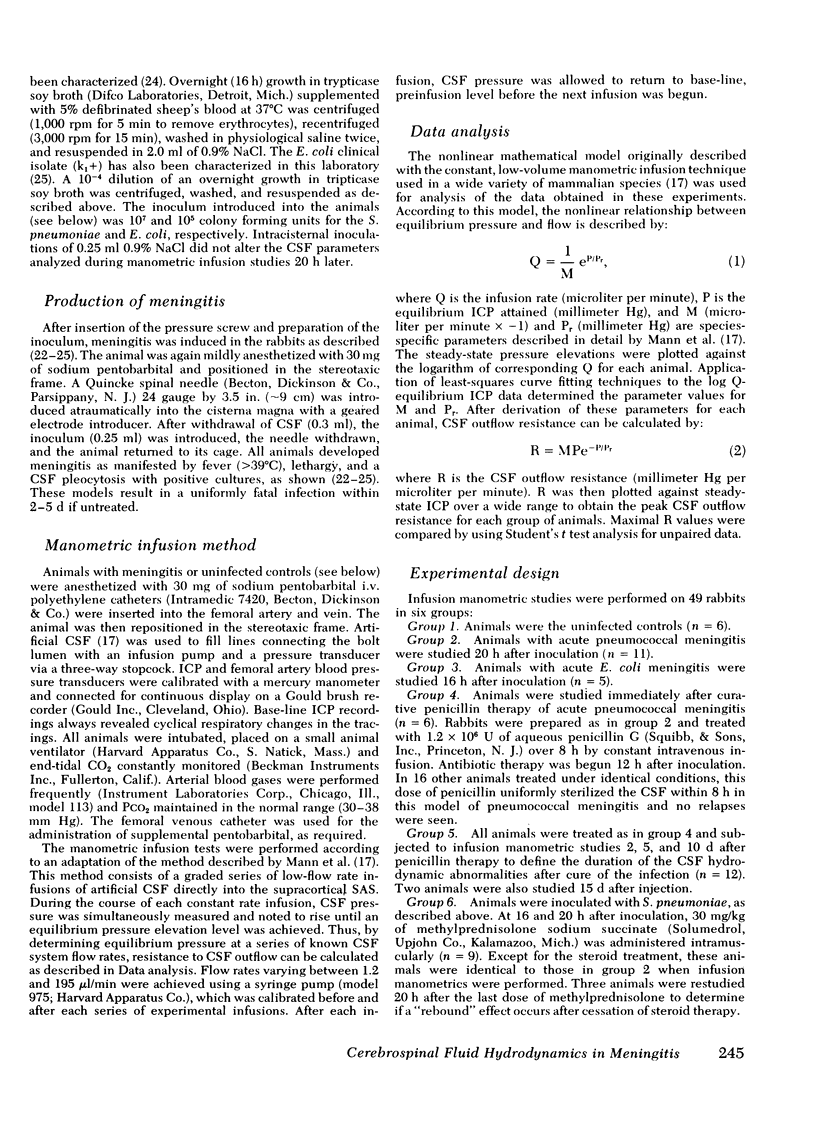


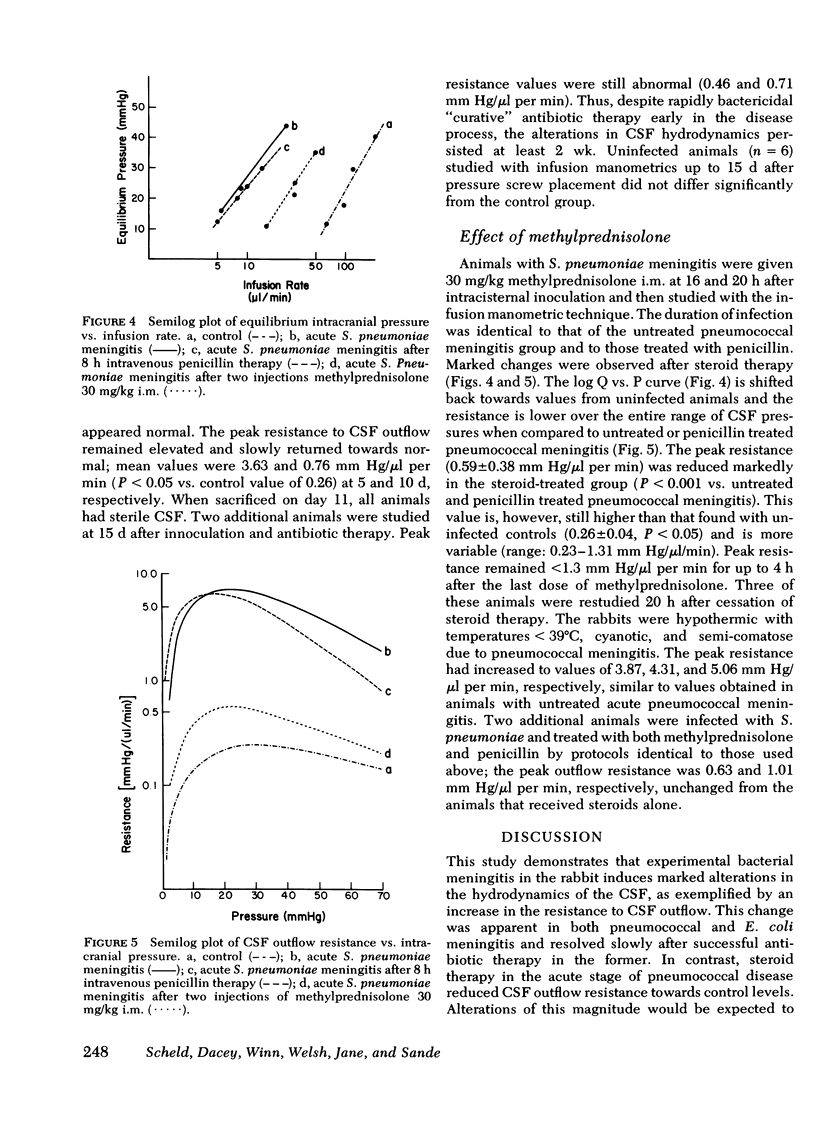
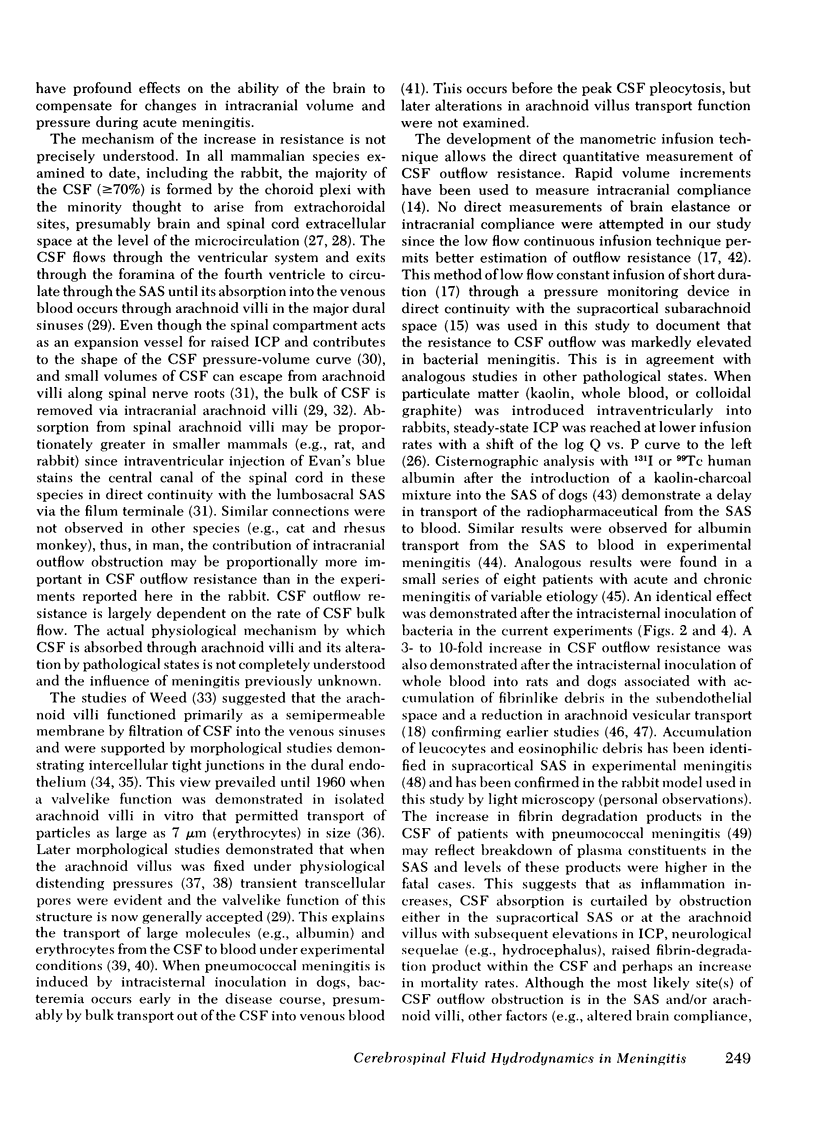

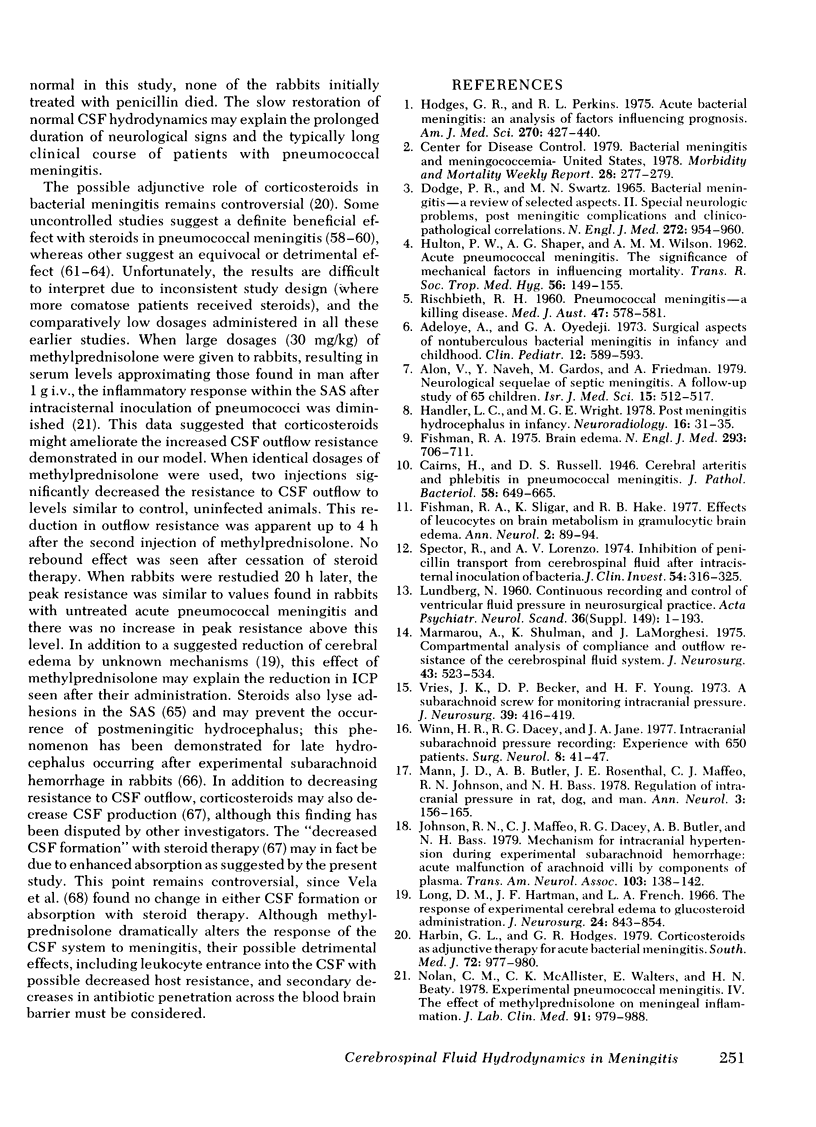
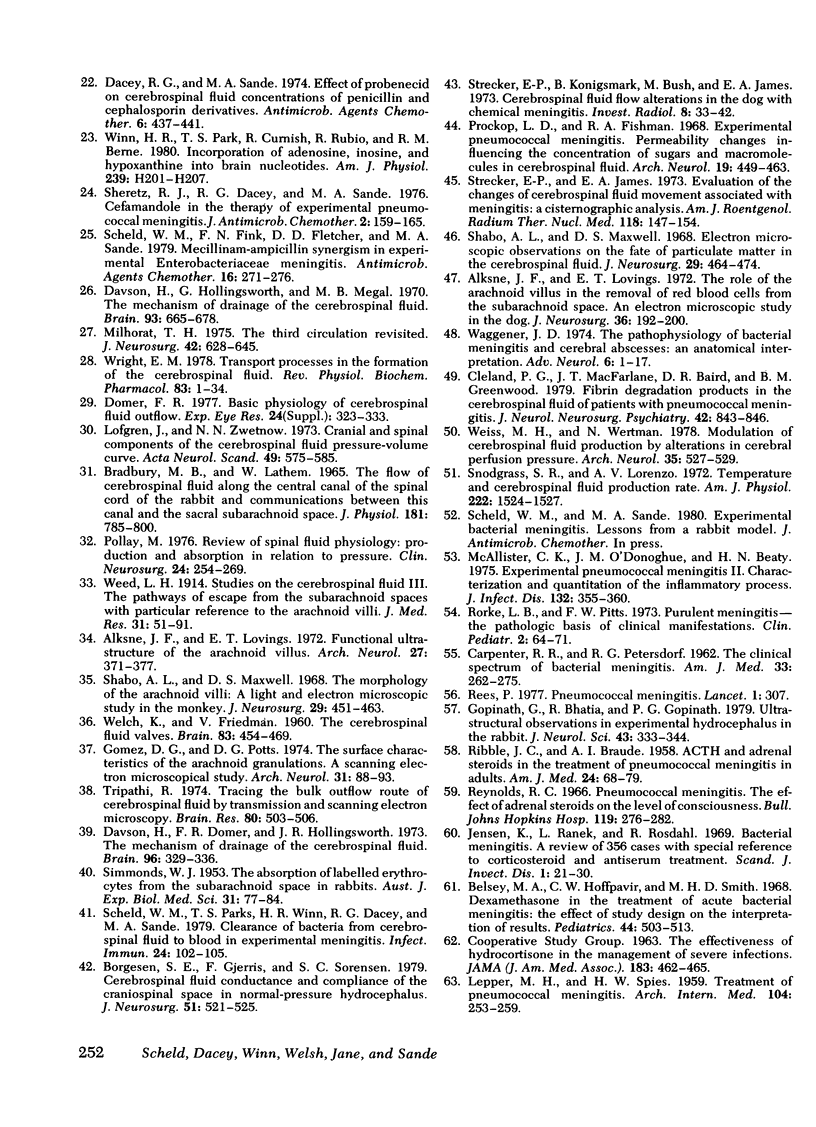
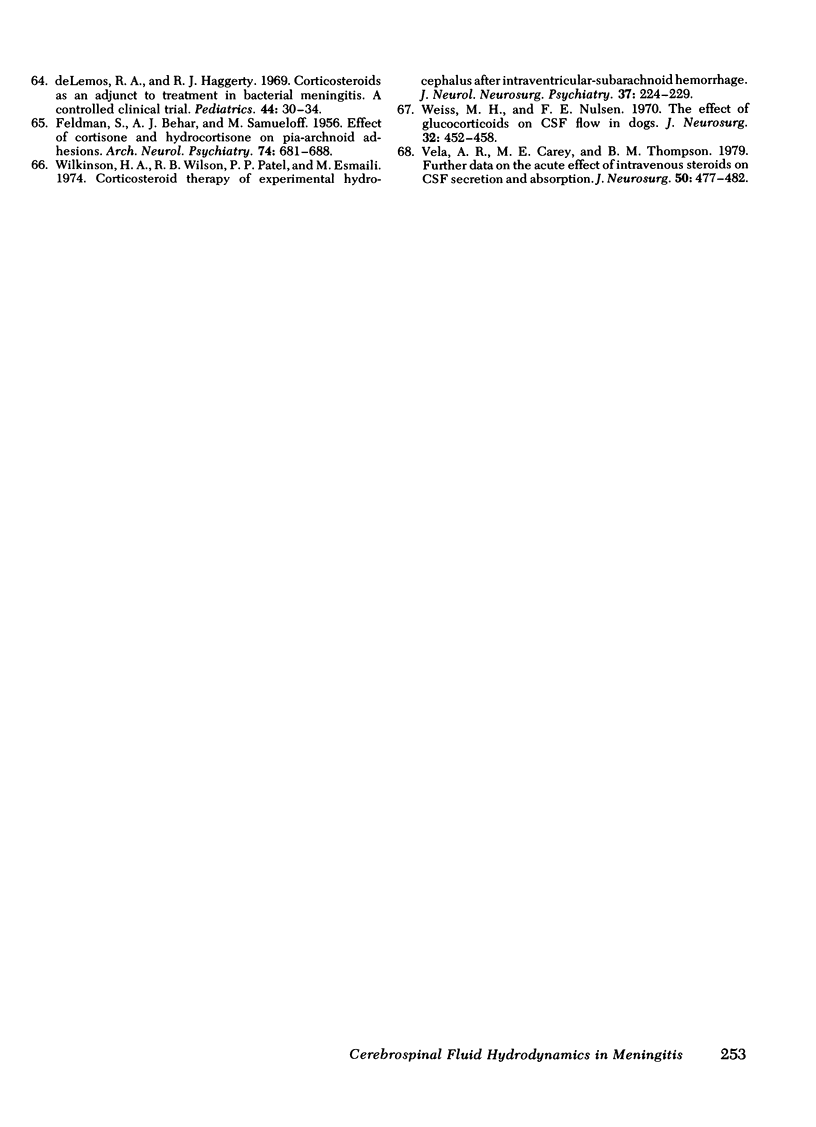
Selected References
These references are in PubMed. This may not be the complete list of references from this article.
- Adeloye A., Oyedeji G. A. Surgical aspects of nontuberculous bacterial meningitis in infancy and childhood. The successful use of conservative surgery in management of some of its complications. Clin Pediatr (Phila) 1973 Oct;12(10):589–593. doi: 10.1177/000992287301201105. [DOI] [PubMed] [Google Scholar]
- Alksne J. F., Lovings E. T. Functional ultrastructure of the arachnoid villus. Arch Neurol. 1972 Nov;27(5):371–377. doi: 10.1001/archneur.1972.00490170003002. [DOI] [PubMed] [Google Scholar]
- Alksne J. F., Lovings E. T. The role of the arachnoid villus in the removal of red blood cells from the subarachnoid space. An electron microscope study in the dog. J Neurosurg. 1972 Feb;36(2):192–200. doi: 10.3171/jns.1972.36.2.0192. [DOI] [PubMed] [Google Scholar]
- Alon U., Naveh Y., Gardos M., Friedman A. Neurological sequelae of septic meningitis. A follow-up study of 65 children. Isr J Med Sci. 1979 Jun;15(6):512–517. [PubMed] [Google Scholar]
- Belsey M. A., Hoffpauir C. W., Smith M. H. Dexamethasone in the treatment of acute bacterial meningitis: the effect of study design on the interpretation of results. Pediatrics. 1969 Oct;44(4):503–513. [PubMed] [Google Scholar]
- Bradbury M. W., Lathem W. A flow of cerebrospinal fluid along the central canal of the spinal cord of the rabbit and communications between this canal and the sacral subarachnoid space. J Physiol. 1965 Dec;181(4):785–800. doi: 10.1113/jphysiol.1965.sp007797. [DOI] [PMC free article] [PubMed] [Google Scholar]
- Børgesen S. E., Gjerris F., Sørensen S. C. Cerebrospinal fluid conductance and compliance of the craniospinal space in normal-pressure hydrocephalus. A comparison between two methods for measuring conductance to outflow. J Neurosurg. 1979 Oct;51(4):521–525. doi: 10.3171/jns.1979.51.4.0521. [DOI] [PubMed] [Google Scholar]
- CARPENTER R. R., PETERSDORF R. G. The clinical spectrum of bacterial meningitis. Am J Med. 1962 Aug;33:262–275. doi: 10.1016/0002-9343(62)90024-4. [DOI] [PubMed] [Google Scholar]
- Cleland P. G., Macfarlane J. T., Baird D. R., Greenwood B. M. Fibrin degradation products in the cerebrospinal fluid of patients with pneumococcal meningitis. J Neurol Neurosurg Psychiatry. 1979 Sep;42(9):843–846. doi: 10.1136/jnnp.42.9.843. [DOI] [PMC free article] [PubMed] [Google Scholar]
- DODGE P. R., SWARTZ M. N. BACTERIAL MENINGITIS--A REVIEW OF SELECTED ASPECTS. II. SPECIAL NEUROLOGIC PROBLEMS, POSTMENINGITIC COMPLACATIONS AND CLINICOPATHOLOGICAL CORRELATIONS. N Engl J Med. 1965 May 6;272:954–CONTD. doi: 10.1056/NEJM196505062721806. [DOI] [PubMed] [Google Scholar]
- Dacey R. G., Sande M. A. Effect of probenecid on cerebrospinal fluid concentrations of penicillin and cephalosporin derivatives. Antimicrob Agents Chemother. 1974 Oct;6(4):437–441. doi: 10.1128/aac.6.4.437. [DOI] [PMC free article] [PubMed] [Google Scholar]
- Davson H., Domer F. R., Hollingsworth J. R. The mechanism of drainage of the cerebrospinal fluid. Brain. 1973 Jun;96(2):329–336. doi: 10.1093/brain/96.2.329. [DOI] [PubMed] [Google Scholar]
- Davson H., Hollingsworth G., Segal M. B. The mechanism of drainage of the cerebrospinal fluid. Brain. 1970;93(4):665–678. doi: 10.1093/brain/93.4.665. [DOI] [PubMed] [Google Scholar]
- DeLemos R. A., Haggerty R. J. Corticosteroids as an adjunct to treatment in bacterial meningitis. A controlled clinical trial. Pediatrics. 1969 Jul;44(1):30–34. [PubMed] [Google Scholar]
- Domer F. R. Basic physiology of cerebrospinal fluid outflow. Exp Eye Res. 1977;25 (Suppl):323–332. doi: 10.1016/s0014-4835(77)80029-8. [DOI] [PubMed] [Google Scholar]
- FELDMAN S., BEHAR A. J., SAMUELOFF M. Effect of cortisone and hydrocortisone on piarachnoid adhesions; an experimental study. AMA Arch Neurol Psychiatry. 1955 Dec;74(6):681–688. doi: 10.1001/archneurpsyc.1955.02330180099009. [DOI] [PubMed] [Google Scholar]
- Fishman R. A. Brain edema. N Engl J Med. 1975 Oct 2;293(14):706–711. doi: 10.1056/NEJM197510022931407. [DOI] [PubMed] [Google Scholar]
- Gomez D. G., Potts D. G. The surface characteristics of arachnoid granulations. Arch Neurol. 1974 Aug;31(2):88–93. doi: 10.1001/archneur.1974.00490380036003. [DOI] [PubMed] [Google Scholar]
- Gopinath G., Bhatia R., Gopinath P. G. Ultrastructural observations in experimental hydrocephalus in the rabbit. J Neurol Sci. 1979 Nov;43(3):333–334. doi: 10.1016/0022-510x(79)90013-3. [DOI] [PubMed] [Google Scholar]
- HUTTON P. W., SHAPER A. G., WILSON A. M. Acute pneumococcal meningitis. The significance of mechanical factors in influencing moratality. Trans R Soc Trop Med Hyg. 1962 Mar;56:149–155. doi: 10.1016/0035-9203(62)90142-6. [DOI] [PubMed] [Google Scholar]
- Handler L. C., Wright M. G. Postmeningitic hydrocephalus in infancy. Ventriculography with special reference to ventricular septa. Neuroradiology. 1978;16:31–35. doi: 10.1007/978-3-642-66959-0_11. [DOI] [PubMed] [Google Scholar]
- Harbin G. L., Hodges G. R. Corticosteroids as adjunctive therapy for acute bacterial meningitis. South Med J. 1979 Aug;72(8):977–980. doi: 10.1097/00007611-197908000-00024. [DOI] [PubMed] [Google Scholar]
- Hodges G. R., Perkins R. L. Acute bacterial meningitis: an analysis of factors influencing prognosis. Am J Med Sci. 1975 Nov-Dec;270(3):427–440. doi: 10.1097/00000441-197511000-00003. [DOI] [PubMed] [Google Scholar]
- Jensen K., Ranek L., Rosdahl N. Bacterial meningitis; a review of 356 cases with special reference to corticosteroid and antiserum treatment. Scand J Infect Dis. 1969 May;1(1):21–30. doi: 10.3109/inf.1969.1.issue-1.04. [DOI] [PubMed] [Google Scholar]
- Johnson R. N., Maffeo C. J., Dacey R. G., Butler A. B., Bass N. H. Mechanism for intracranial hypertension during experimental subarachnoid hemorrhage: acute malfunction of arachnoid villi by components of plasma. Trans Am Neurol Assoc. 1978;103:138–142. [PubMed] [Google Scholar]
- LEPPER M. H., SPIES H. W. Treatment of pneumococcic meningitis; results when penicillin was used alone compared with those when penicillin and streptomycin were used together, with and without hydrocortisone: alternate patient studies. AMA Arch Intern Med. 1959 Aug;104(2):253–259. doi: 10.1001/archinte.1959.00270080079010. [DOI] [PubMed] [Google Scholar]
- LUNDBERG N. Continuous recording and control of ventricular fluid pressure in neurosurgical practice. Acta Psychiatr Scand Suppl. 1960;36(149):1–193. [PubMed] [Google Scholar]
- Long D. M., Hartmann J. F., French L. A. The response of experimental cerebral edema to glucosteroid administration. J Neurosurg. 1966 May;24(5):843–854. doi: 10.3171/jns.1966.24.5.0843. [DOI] [PubMed] [Google Scholar]
- Löfgren J., Zwetnow N. N. Cranial and spinal components of the cerebrospinal fluid pressure-volume curve. Acta Neurol Scand. 1973;49(5):575–585. doi: 10.1111/j.1600-0404.1973.tb01331.x. [DOI] [PubMed] [Google Scholar]
- Mann J. D., Butler A. B., Rosenthal J. E., Maffeo C. J., Johnson R. N., Bass N. H. Regulation of intracranial pressure in rat, dog, and man. Ann Neurol. 1978 Feb;3(2):156–165. doi: 10.1002/ana.410030212. [DOI] [PubMed] [Google Scholar]
- Marmarou A., Shulman K., LaMorgese J. Compartmental analysis of compliance and outflow resistance of the cerebrospinal fluid system. J Neurosurg. 1975 Nov;43(5):523–534. doi: 10.3171/jns.1975.43.5.0523. [DOI] [PubMed] [Google Scholar]
- McAllister C. K., O'Donoghue J. M., Beaty H. N. Experimental pneumococcal meningitis. II. Characterization and quantitation of the inflammatory process. J Infect Dis. 1975 Oct;132(4):355–360. doi: 10.1093/infdis/132.4.355. [DOI] [PubMed] [Google Scholar]
- Milhorat T. H. The third circulation revisited. J Neurosurg. 1975 Jun;42(6):628–645. doi: 10.3171/jns.1975.42.6.0628. [DOI] [PubMed] [Google Scholar]
- Nolan C. M., McAllister C. K., Walters E., Beaty H. N. Experimental pneumococcal meningitis. IV. The effect of methyl prednisolone on meningeal inflammation. J Lab Clin Med. 1978 Jun;91(6):979–988. [PubMed] [Google Scholar]
- Pollay M. Review of spinal fluid physiology: production and absorption in relation to pressure. Clin Neurosurg. 1977;24:254–269. doi: 10.1093/neurosurgery/24.cn_suppl_1.254. [DOI] [PubMed] [Google Scholar]
- Prockop L. D., Fishman R. A. Experimental pneumococcal meningitis. Permeability changes influencing the concentration of sugars and macromolecules in cerebrospinal fluid. Arch Neurol. 1968 Nov;19(5):449–463. doi: 10.1001/archneur.1968.00480050019001. [DOI] [PubMed] [Google Scholar]
- RIBBLE J. C., BRAUDE A. I. ACTH and adrenal steroids in the treatment of pneumococcal meningitis in adults. Am J Med. 1958 Jan;24(1):68–79. doi: 10.1016/0002-9343(58)90363-2. [DOI] [PubMed] [Google Scholar]
- RISCHBIETH R. H. Pneumonococcal meningitis-a killing disease. Med J Aust. 1960 Apr 9;47(1):578–581. [PubMed] [Google Scholar]
- RORKE L. B., PITTS F. W. Purulent meningitis: the pathologic basis of clinical manifestations. Clin Pediatr (Phila) 1963 Feb;2:64–71. doi: 10.1177/000992286300200205. [DOI] [PubMed] [Google Scholar]
- Rees P. Pneumococcal meningitis. Lancet. 1977 Feb 5;1(8006):307–307. doi: 10.1016/s0140-6736(77)91852-9. [DOI] [PubMed] [Google Scholar]
- SIMMONDS W. J. The absorption of labelled erythrocytes from the subarachnoid space in rabbits. Aust J Exp Biol Med Sci. 1953 Feb;31(1):77–83. doi: 10.1038/icb.1953.10. [DOI] [PubMed] [Google Scholar]
- Scheld W. M., Fink F. N., Fletcher D. D., Sande M. A. Mecillinam-ampicillin synergism in experimental Enterobacteriaceae meningitis. Antimicrob Agents Chemother. 1979 Sep;16(3):271–276. doi: 10.1128/aac.16.3.271. [DOI] [PMC free article] [PubMed] [Google Scholar]
- Scheld W. M., Park T. S., Dacey R. G., Winn H. R., Jane J. A., Sande M. A. Clearance of bacteria from cerebrospinal fluid to blood in experimental meningitis. Infect Immun. 1979 Apr;24(1):102–105. doi: 10.1128/iai.24.1.102-105.1979. [DOI] [PMC free article] [PubMed] [Google Scholar]
- Sheretz R. J., Dacey R., Sande M. A. Cefamandole in the therapy of experimental pneumococcal meningitis. J Antimicrob Chemother. 1976 Jun;2(2):159–165. doi: 10.1093/jac/2.2.159. [DOI] [PubMed] [Google Scholar]
- Snodgrass S. R., Lorenzo A. V. Temperature and cerebrospinal fluid production rate. Am J Physiol. 1972 Jun;222(6):1524–1527. doi: 10.1152/ajplegacy.1972.222.6.1524. [DOI] [PubMed] [Google Scholar]
- Spector R., Lorenzo A. V. Inhibition of penicillin transport from the cerebrospinal fluid after intracisternal inoculation of bacteria. J Clin Invest. 1974 Aug;54(2):316–325. doi: 10.1172/JCI107767. [DOI] [PMC free article] [PubMed] [Google Scholar]
- Strecker E. P., James A. E., Jr Evaluation of the changes of cerebrospinal fluid movement associated with meningitis: a cisternographic analysis. Am J Roentgenol Radium Ther Nucl Med. 1973 May;118(1):147–154. doi: 10.2214/ajr.118.1.147. [DOI] [PubMed] [Google Scholar]
- Strecker E. P., Konigsmark B., Bush M., James A. E., Jr Cerebrospinal fluid flow alterations in the dog with chemical meningitis. Invest Radiol. 1973 Jan-Feb;8(1):33–42. doi: 10.1097/00004424-197301000-00006. [DOI] [PubMed] [Google Scholar]
- Tripathi R. Tracing the bulk outflow route of cerebrospinal fluid by transmission and scanning electron microscopy. Brain Res. 1974 Nov 22;80(3):503–506. doi: 10.1016/0006-8993(74)91033-6. [DOI] [PubMed] [Google Scholar]
- Vela A. R., Carey M. E., Thompson B. M. Further data on the acute effect of intravenous steroids on canine CSF secretion and absorption. J Neurosurg. 1979 Apr;50(4):477–482. doi: 10.3171/jns.1979.50.4.0477. [DOI] [PubMed] [Google Scholar]
- Vries J. K., Becker D. P., Young H. F. A subarachnoid screw for monitoring intracranial pressure. Technical note. J Neurosurg. 1973 Sep;39(3):416–419. doi: 10.3171/jns.1973.39.3.0416. [DOI] [PubMed] [Google Scholar]
- WELCH K., FRIEDMAN V. The cerebrospinal fluid valves. Brain. 1960 Sep;83:454–469. doi: 10.1093/brain/83.3.454. [DOI] [PubMed] [Google Scholar]
- Waggener J. D. The pathophysiology of bacterial meningitis and cerebral abscesses: an anatomical interpretation. Adv Neurol. 1974;6:1–17. [PubMed] [Google Scholar]
- Weiss M. H., Nulsen F. E. The effect of glucocorticoids on CSF flow in dogs. J Neurosurg. 1970 Apr;32(4):452–458. doi: 10.3171/jns.1970.32.4.0452. [DOI] [PubMed] [Google Scholar]
- Weiss M. H., Wertman N. Modulation of CSF production by alterations in cerebral perfusion pressure. Arch Neurol. 1978 Aug;35(8):527–529. doi: 10.1001/archneur.1978.00500320047010. [DOI] [PubMed] [Google Scholar]
- Wilkinson H. A., Wilson R. B., Patel P. P., Esmaili M. Corticosteroid therapy of experimental hydrocephalus after intraventricular-subarachnoid haemorrhage. J Neurol Neurosurg Psychiatry. 1974 Feb;37(2):224–229. doi: 10.1136/jnnp.37.2.224. [DOI] [PMC free article] [PubMed] [Google Scholar]
- Winn H. R., Dacey R. G., Jane J. A. Intracranial subarachnoid pressure recording: experience with 650 patients. Surg Neurol. 1977 Jul;8(1):41–47. [PubMed] [Google Scholar]
- Wright E. M. Transport processes in the formation of the cerebrospinal fluid. Rev Physiol Biochem Pharmacol. 1978;83:3–34. [PubMed] [Google Scholar]


